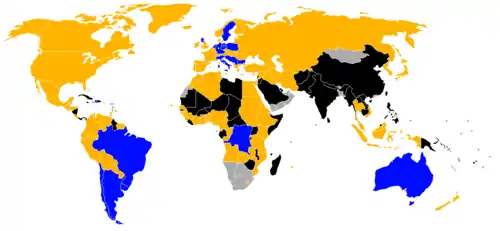1974 FIFA World Cup qualification
99 teams entered the 1974 FIFA World Cup qualification rounds, competing for 16 spots in the final tournament. West Germany, as the hosts, and Brazil, as the defending champions, qualified automatically, leaving 14 spots open for competition.
| Tournament details | |
|---|---|
| Dates | 14 November 1971 – 13 February 1974 |
| Teams | 99 (from 6 confederations) |
| Tournament statistics | |
| Matches played | 226 |
| Goals scored | 620 (2.74 per match) |
| Top scorer(s) | |
The 16 spots available in the 1974 World Cup would be distributed among the continental zones as follows:
- Europe (UEFA): 9.5 places, 1 of them went to automatic qualifier West Germany, while the other 8.5 places were contested by 32 teams. The winner of the 0.5 place would advance to the Intercontinental Play-offs (against a team from CONMEBOL).
- South America (CONMEBOL): 3.5 places, 1 of them went to automatic qualifier Brazil, while the other 2.5 places were contested by 9 teams. The winner of the 0.5 place would advance to the Intercontinental Play-offs (against a team from UEFA).
- North, Central America and Caribbean (CONCACAF): 1 place, contested by 14 teams.
- Africa (CAF): 1 place, contested by 24 teams.
- Asia (AFC) and Oceania (OFC): 1 place, contested by 18 teams.
90 teams played at least one qualifying match. 226 qualifying matches were played, and 620 goals were scored (an average of 2.74 per match).
Continental Zones
To see the dates and results of the qualification rounds for each continental zone, click on the following articles:
- Group 1 - Sweden qualified.
- Group 2 - Italy qualified.
- Group 3 - Netherlands qualified.
- Group 4 - East Germany qualified.
- Group 5 - Poland qualified.
- Group 6 - Bulgaria qualified.
- Group 7 - Yugoslavia qualified.
- Group 8 - Scotland qualified.
- Group 9 - Soviet Union advanced to the UEFA / CONMEBOL Intercontinental Play-off.
- Group 1 - Uruguay qualified.
- Group 2 - Argentina qualified.
- Group 3 - Chile advanced to the UEFA / CONMEBOL Intercontinental Play-off.
- Haiti qualified.
- Zaire qualified.
- Australia qualified.
Inter-confederation play-offs: UEFA v CONMEBOL
The teams would play against each other on a home-and-away basis. The winner would qualify.
The second leg was scratched as the Soviet Union were disqualified after they refused to travel to Santiago for the return leg due to the recent Chilean coup d'état and the executions of left-wing prisoners in the Santiago stadium. The match did "go ahead" with the eleven Chilean players facing zero Soviet players before thousands of bemused spectators,[1] and half a dozen Chilean players slowly passed the ball to each other in mock play until the captain walked the ball into the net.
| Team 1 | Agg. | Team 2 | 1st leg | 2nd leg |
|---|---|---|---|---|
| Soviet Union |
w.o.[note 1] | 0–0 | 0–2[note 1] |
Qualified teams

The following 16 teams qualified for the 1974 FIFA World Cup:
| Team | Finals Appearance | Streak | Last Appearance |
|---|---|---|---|
| 6th | 1 | 1966 | |
| 1st | 1 | – | |
| 10th | 10 | 1970 | |
| 4th | 4 | 1970 | |
| 5th | 1 | 1966 | |
| 1st | 1 | – | |
| 1st | 1 | – | |
| 8th | 4 | 1970 | |
| 3rd | 1 | 1938 | |
| 2nd | 1 | 1938 | |
| 3rd | 1 | 1958 | |
| 6th | 2 | 1970 | |
| 7th | 4 | 1970 | |
| 8th | 6 | 1970 | |
| 6th | 1 | 1962 | |
| 1st | 1 | – |
(h) - qualified automatically as hosts
(c) - qualified automatically as defending champions
8 of the 16 teams subsequently failed to qualify for the 1978 finals: Australia, Bulgaria, Chile, East Germany, Haiti, Uruguay, Yugoslavia and Zaire.
Top goalscorers
- 12 goals
- 11 goals
- 7 goals
Notes
- The Soviet Union refused to play in Chile for the second leg, so Chile were awarded a 2–0 walkover victory.
- For the first time in the qualifiers, goal difference was used as a tie-breaker for teams who finished level on points. Aggregate score was also used to determine the winners of two-legged ties.
- Australia was the first team from OFC to qualify for a World Cup.